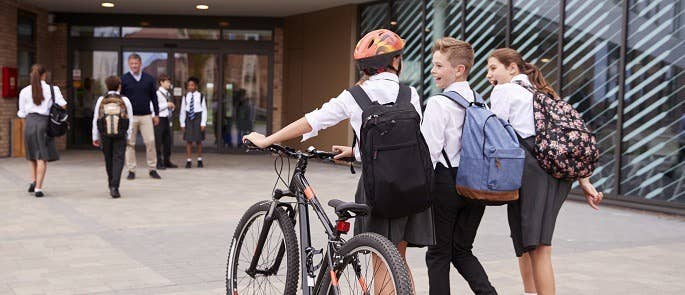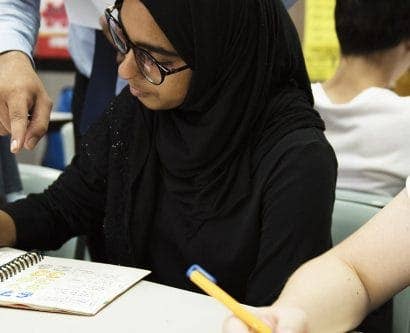What is Trauma Informed Practice in Schools?
It’s estimated that one in three children are exposed to at least one potentially traumatic event by the age of 18. Unfortunately, we know that trauma can have a significant impact on mental health outcomes, social development, academic attainment, cognitive development and behaviour, so it’s essential that those working in education are aware of how to help minimise the impact of trauma.
In this article, we will outline what trauma-informed practice is and the effects of trauma on children. We will also explain how you can make space for trauma-informed practice in school, as well as provide you with a range of strategies that you can use.
‘A teacher must manage behaviour effectively to ensure a good and safe learning environment…using approaches which are appropriate to pupils’ needs in order to involve and motivate them.’
Teachers’ Standards, Department for Education

What is Trauma Informed Practice?
In defining trauma informed practice, we must also consider the meaning of adversity, trauma and adverse childhood experience (ACE).
Adversity
Adversity tends to be something that children experience over a long period of time, and it’s often not a single event. Examples of adversity include neglect, community violence and bullying.
Many children living with adversity, or those who can utilise the warmth and support of a caregiver or community network, can recover from its impact. However, where children are left unsupported and isolated from effective care, the impact of adversity can be lifelong.
Adverse childhood experience (ACE)
ACEs differ somewhat from the general meaning of adversity as they are a set of clearly defined stressful and/or traumatic circumstances, such as living with someone who has gone to prison, or losing a parent through divorce, abandonment or death. You can find out more about adverse childhood experiences and their impact here.
Trauma
Trauma occurs when an individual experiences an overwhelming event that is often beyond their ability to cope with and process. It is a significant disruption in somebody’s life that impacts both their body and mind.
Trauma can be used to describe the event itself, the reaction to it or the lack of a trusting and nurturing support network to help the individual cope with the trauma.
It can be a single event, such as being injured in a car accident, or prolonged, long-term exposure, such as living with physically and emotionally abusive caregivers.
Trauma informed practice
Trauma-informed practice is a universal framework, widely used within the health and education sectors. Its aim is to meet the needs of those individuals who have experienced trauma through strategy, policy, continuous learning and intervention.
Unlike trauma specific services which treat trauma through therapies, trauma-informed organisations recognise that people who have had traumatic experiences can find it challenging to feel safe and develop trusting relationships. Staff have a strong understanding of how trauma can affect many aspects of an individual’s life and therefore aim to promote trust and prevent re-traumatisation by providing safe, stable environments in which children can flourish.
Schools who adopt trauma-informed practice have a sound understanding of child development. Staff know how children’s brains develop and help them with their emotional regulation, knowing that this will help to safeguard their future mental health.
In helping those children with direct experiences of trauma, a trauma-informed organisation inadvertently supports all children’s psychological, emotional and social development.

What are the Effects of Trauma on Children?
‘Childhood trauma is the largest modifiable risk factor for future mental health problems.’
Professor Eamon McCrory
Exposure to trauma can have lasting effects on an individual, especially when the individual is not supported in managing the impact of the trauma. It’s important to remember here that people respond to trauma differently. Some people are not ‘traumatised’ by the trauma they experience; others’ responses may be immediately apparent or manifest themselves over time.
The effects of trauma, both short-term and long-term, can include the following internalising and externalising behaviours:
- Increased heart rate.
- Bet wetting.
- Nightmares.
- Increased levels of stress and heightened anxiety.
- Hypervigilance.
- Decreased self-esteem.
- Increased likelihood of engaging in risk taking behaviours, such as alcohol or substance abuse.
- Developmental delay.
- Inability to form trusting relationships.
- Difficulty in expressing emotions.
- Inability to manage their emotions.
- Increased likelihood of later mental health difficulties.

What are the Benefits of Trauma Informed Practice?
There are innumerable benefits of becoming a trauma-informed organisation. These include:
- Improved outcomes for all.
- A more connected and respectful school environment.
- A reduction in challenging behaviour.
- Higher inclusion rates.
- Lower exclusion rates.
- An ability to model and sustain reliable attachment.
- Improved sense of belonging.
- Students who are calmer and ready to learn.
- Students who are better equipped to manage their emotions, with higher levels of self-esteem, empathy and resilience.
- Students who feel understood, valued and safe.
‘Safeguarding and promoting the welfare of children is everyone’s responsibility…All practitioners should make sure their approach is child centred…Safeguarding and promoting the welfare of children is defined as: protecting children from maltreatment; preventing the impairment of children’s mental and physical health or development; ensuring that children grow up in circumstances consistent with the provision of safe and effective care, and taking action to enable all children to have the best outcomes.’
Keeping Children Safe in Education
How to Make Space for Trauma Informed Practice in Schools
Trauma-informed practice is not a new initiative – something to trial, monitor and then replace with a new strategy six months later. It should lie at the heart of the curriculum, be valued by all those in the school community and be reflected within each and every school policy. It is a change in culture.
For the practice to be successful, those working closely with children should recognise and appreciate the impact of trauma. Their role is to do all they can to lessen the impact of trauma on learning, so that children find fulfilment and achieve their potential.
Teaching and Education Courses
Find out more about our teaching and education courses, including titles such as Child Mental Health, Special Educational Needs in the Classroom and Challenging Behaviour.

Trauma Informed Classroom Strategies
There are steps that you can take within the classroom in order to become trauma aware. These should complement your school’s wider trauma-informed practices. Although every school’s approach will vary, the following themes should remain consistent:
Curiosity
‘We need to be curious, not furious.’
Betsy de Thierry, Founder of the Trauma Recovery Centre
Consider this example: On their first day of year seven, a child is reprimanded and punished by their teacher for shouting out in class and trying to gain the attention of their peers. In reality, they are just feeling overwhelmed by the lack of routine in the class and the many uncertainties that exist within the new environment. The child has also had limited social contact during the holidays as they have been staying with grandma in a different town. The teacher’s loud shouting has only served to exacerbate the child’s behaviour – as it has triggered them to remember the sound of an abusive caregiver.
If children feel threatened or afraid, their brain reverts to flight, fight or freeze mode. The pre-frontal cortex (commonly understood as the part of the brain associated with thought processes which are vital for learning – such as reasoning, reflection and cause and effect) is less developed in a child’s brain. Therefore, if they experience something at school which acts as a trigger, or they feel scared or uncertain, they are less able to control their response. It also may be that a child doesn’t feel able, or is unable, to articulate how they are feeling.
Therefore, education professionals should aim to be curious about the causes of the behaviour, not angry at what they see presented before them. They must understand that all behaviour is a form of communication, reflecting a need, and that a child’s defensive behaviours may not be personal to them.
Instead of seeing behaviour that challenges as something we must respond to with decisive action or punishment, we should aim to reframe our thinking to see the child as in need of our help. Effective and well-planned transitions between schools and teachers can also help staff to appreciate children’s exposure to trauma and adversity.
Ultimately, staff who are trauma informed do not punish behaviour and responses which are trauma symptoms.

Safety
In order to not activate the fear system or cause re-traumatisation, teachers must do all they can to help create a safe and stimulating environment for their pupils – one that provides them with freedom from harm or threat. A nurturing space, which provides consistent care and encouragement, can also support children in managing their emotions and regulating stresses.
Trust
Nurturing and maintaining effective relationships in the classroom is a key aspect of trauma-informed practice. When children feel safe and secure with the adults around them, they are more likely to flourish. Uncertainties are removed thanks to established, trusting relationships.
Nurturing relationships can support children as they recover from trauma, and they can also make them more resilient to negative experiences.
This is especially important for more vulnerable groups, such as those involved with the care sector. We know that around three quarters of children go into care as a result of abuse or neglect. These children require empathy above all else and education professionals working with them should recognise that they are involved in the system because of what has been done to them, not what they have done.
Promoting active listening within classrooms, where children and adults listen sensitively and compassionately, can, for example, help to lay the foundations for more trusting and respectful relationships. This form of listening encourages children to empathise more with others, which in turn improves community connectedness. If a child tells you something, give them a safe space in which to reply. Try to listen with an open mind and without judgement, and acknowledge and value their thoughts. You can find out more about communication skills for teachers here.
‘We expect adults to support children by understanding the impact of a child’s history on their behaviour, including any past trauma or special educational needs, and seeking specialist help when necessary. We expect adults to be skilled and confident in finding the best ways to keep children safe: ways that promote their rights, respect their dignity and help equip them for the future.’
Positive Environments Where Children Can Flourish, Ofsted, 2021
Positive wellbeing
Schools that are trauma informed promote positive wellbeing. This helps children to manage their emotions and recognise the importance of a reliable support network. This is often delivered through formal and informal structured sessions and interventions. To find out more about how to promote positive mental health, take a look at our mental health resource pack for schools.
Learning
Continuous learning and impactful professional development opportunities can help those working closely with children to expand their knowledge of trauma and its impact. Refreshing your understanding of child development, for example, can help you to improve outcomes for the children you work with. Having a secure understanding of how a child’s brain develops and how it can be impacted by trauma will help you to manage student behaviour more effectively.

Trauma-informed schools create safe and nurturing environments, help children to manage their emotions, and promote connection and empathy. They understand the relationship between children’s cognitive development and the impacts of trauma, and recognise the importance of building supportive and trusting relationships. Trauma-informed practices in schools support children without judgement and can help all children to flourish.
Further Resources:
- Courses for Teaching and Education
- Adverse Childhood Experiences: Guidance for Schools
- Safeguarding Children Legislation
- What is Adultification within Child Protection and Safeguarding?
- Effective Interventions in Education: Types and Examples
- What is the Toxic Trio?
- Child Sexual Abuse: Guidance for Schools
- Supporting Young Carers: A Guide for Teachers











